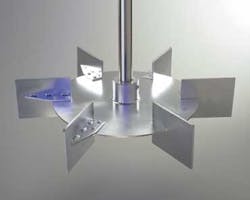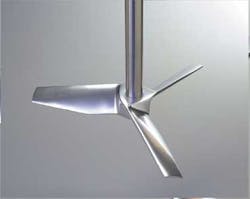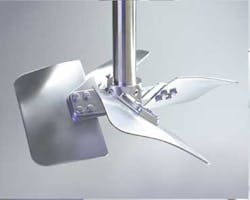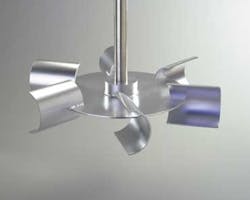Efficient agitators disperse gas, keep solids suspended and circulate tank contents in multiphase systems
Many processes involve simple liquid or liquid-solid mixing. However, gas-liquid or gas-liquid-solid applications are more complex from both the process and mechanical design perspectives. Although a variety of impellers is available for mixing in multi-phase systems, no single approach is ideal for every application.
Flat-bladed turbine
Figure 1. Flat-bladed Old Faithful
The flat-bladed impeller, the historic standard for gas-liquid applications, is not efficient for solids suspension.
The shape of the Rushton turbine blade and the vortex that forms behind it lead to a marked decrease in power draw when gas is introduced. Two-speed motors can optimize the drive system for both gassed and ungassed operation.
The variety of specialized gas handling impellers is better suited for dispersing gas than the Rushton turbine. However, applications requiring high-shear or high-energy dissipation rates remain the primary use for flat-blade turbines.
High-efficiency impellers
Figure 2. Fluidfoil Floods Frequently
High-efficiency fluidfoil impellers develop the greatest pumping rate for a given power output, but are prone to gas flooding.
A conventional, down-flow, high-efficiency fluidfoil impeller is the best choice for suspension of a solid-liquid slurry when there are small amounts of impurities to be oxidized using sparged air. Low gas rates don't affect the impeller's power draw markedly.
As the ratio of gas volume to impeller pumping capacity exceeds 2 percent, conventional fluidfoil impellers don't have sufficient blade area to disperse the gas effectively. Much of the gas simply passes through the impeller, a condition known as flooding. The impeller's power draw also fluctuates and drops during the flooded condition.
Gas-dispersing impellers
Figure 3. Does Double Duty
A down-pumping impeller is designed for both solid suspension and gas dispension.
For gas rates below 5 percent, the impeller power draw under gassed conditions is slightly greater than when not gassed. As the gas rate exceeds 5 percent, power draw drops below that of the ungassed condition.
For gas rate between 7.5 percent and 21 percent, the high-efficiency impeller system can be used if the sparger introduces gas below the impeller, just outside its swept diameter. This sparge system uses simple downward-pointing pipes, rather than the conventional perforated ring, which makes it ideal if solids are present.
At the high end of the gas range, the power draw under gassed may drop to 70 percent of that for ungassed operation. Using a two-speed motor avoids under-utilizing the mixer's drive system because it takes advantage of the mixer's power response.
Improved efficiency designs
A more common approach is to use a disc turbine with concave, rather than flat, blades (Fig. 4). The streamlined blade shape reduces power draw and minimizes differences between gassed and ungassed operation.
Figure 4. Radical Radial
A concave disc turbine blade shape reduces impeller power draw and minimizes gas problems.
The concave-bladed impeller can disperse more than twice the gas that a flat-blade turbine can handle before it floods. Thus, concave-blade impellers should be the first option for retrofitting mass transfer-limited, flat-bladed turbines.
Recent gas-liquid process development has focused on up-pumping, high-efficiency, axial flow impeller systems. They were first used for suspending high-settling-rate solids while simultaneously dispersing large volumes of gas.
An up-pumping impeller system generates a strong, single-loop circulation pattern for improved performance in flow-controlled applications (e.g.,blending, solid suspension, heat transfer). The impeller is immune to flooding because pumped liquid and sparged gas directions are concurrent. Strong surface down-flow encourages gas entrainment, a distinct advantage for processes such as hydrogenation.
Power response for an up-pumping impeller is a function of impeller geometry, gas rate and mixer power. As noted for other impellers, single- or multi-speed drives may be appropriate, depending on the case.
Hybrid impeller systems
Hybrid impeller systems also control shear in a reactor, a factor that may be important in microbial and crystallization processes.
Problems & Solutions: Case Studies in Impeller Selection
Forced oxidation of fluegas scrubbing solution Problem: Maintaining precipitated solids in suspension while dispersing large volumes of gas to achieve mass transfer in a vessel with a low depth-to-diameter ratio. Solids can settle to a depth of two to four feet easily.Solution: Replace the original radial flow turbine and circumferential sparger with a high-efficiency, gas-dispersing axial flow mixer. Its downward discharge both disperses the gas and sweeps the tank bottom clean, keeping solids from dropping out. Hydrogenating chemicals and edible oilsProblem: Dispersing and reincorporating sparged gas while maintaining uniform catalyst suspension and high liquid circulation rates for heat removal purposes.Solution: Replace first-generation with newer technology. First-generation used flat-blade, radial flow turbines for gas dispersion, with an upper, down-pumping, axial flow pitched-blade turbine. Minimal liquid coverage encouraged vortex formation and gas entrainment. The mixer required about one hp per 1,000 lb. of vessel contents.Second-generation technology replaced the radial flow with high efficiency, gas-dispersing impellers. This approach produced equal or better process results with 20 percent less mixer power. Improved mass and heat transfer boosted reactor productivity by as much as 30 percent.Third-generation technology featured up-pumping, high-efficiency axial flow impellers to produce a strong circulation pattern that greatly increased both gas hold-up and entrainment from the vessel headspace for improved mass transfer and reaction selectivity. Improvements are application-specific, ranging from 50 percent reduction in batch time at equal power to equal batch time at 60 percent power.
Fermentation Problem: Increasing product yield via improved mass transfer, blending and heat transfer.Solution:
Use high-efficiency, up-pumping impellers. Microbial processes, broth rheology and reactor geometry produce highly application-specific results. At equal power input, using high-efficiency up-pumping impellers in place of radial flow turbines delivered increased oxygen transfer. This is advantageous, but it doesn't always translate to increased yield or productivity because of other process or metabolic limitations.Recent work in a 150-cubic-meter vessel with a 375-kW drive for manufacturing antibiotics produced equal yield at 30 percent reduction in mixer power, an energy savings of 110 kW. Greater performance improvements can be achieved in systems that are circulation-limited by broth viscosity or mechanical interference from heat transfer surfaces.
In another application featuring a fermenter with extensive vertical tube bundles and a broth viscosity of 3000 centipoise, retrofitting the 550-kW proprietary radial-flow impeller system increased yield by more than 30 percent and reduced power consumption by 50 percent. Additionally, spatial variations in broth temperature, which had been on the order of several degrees Centigrade, dropped to 0.2°C.
Paul Kubera is market manager for Biopharm and Sanitary products at Lightnin Americas, Rochester, N.Y.




